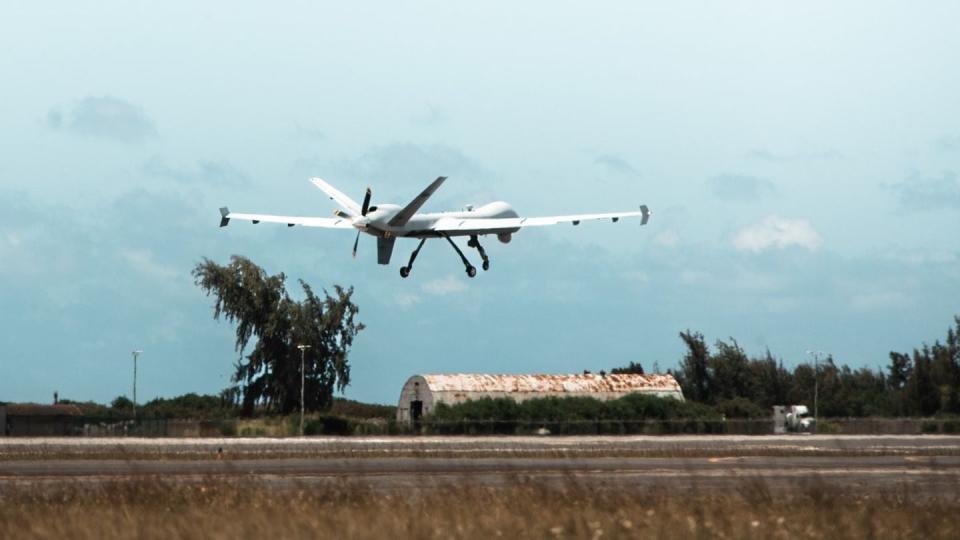Meet the Marine aviator of the year ― an unmanned aerial vehicle pilot
On March 14, Marine Maj. Shane Gentry’s phone started lighting up with text messages from friends and colleagues saying, “Congratulations.”
The texts left Gentry scratching his head. Congratulations for what?
Then someone sent him a link to the Marine administrative message that announced him as the Marine Corps Aviation Association’s aviator of the year.
The award came as a surprise to Gentry, 33, who flies the unmanned MQ-9A aircraft. But he said it made him proud to represent a squadron from the Marine Corps’ unmanned aviation community.
“We’re growing in preponderance,” he said, noting that Marines working in unmanned aviation notched other awards from the association this year. “We’re growing in impact.”
Gentry is the first unmanned aerial vehicle pilot to receive the prestigious aviator of the year award since 2016 at the very least, according to the previous announcements available online. Named for Lt. Col. Alfred Cunningham, the Corps’ first aviator, the award is the highest honor specifically for Marine aviators, according to a Marine news release about Gentry’s award.
Already a seasoned pilot of other unmanned aerial vehicles, Gentry used his real-world experience flying the MQ-9A alongside an Air National Guard unit to get the other aviators in the Hawaii-based Marine Unmanned Aerial Vehicle Squadron 3 up to speed on the new aircraft.
“His talent for imparting his impressive knowledge upon the next generation of pilots is unmatched,” Lt. Col. Nicholas Law, the squadron’s commanding officer, said in a statement to Marine Corps Times.
Gentry grew up in Stafford, Virginia, in a family with a legacy of Marine service. Both his father and grandfather had been in the Marine Corps, and he found himself drawn to the excitement and challenge of the service since elementary school, he said.
Gentry received his commission in 2014. After being in a class on unmanned systems as a newly minted officer at The Basic School, he put that field as his No. 1 choice on his job wishlist. He got it.
Gentry started out flying the RQ-7 Shadow and then moved on to the RQ-21A Blackjack.
In July 2021, Gentry began training on the MQ-9A, the large unmanned aerial vehicle that, according to the 2022 Marine aviation plan, the Corps plans to use primarily for surveillance and reconnaissance. The aircraft can lurk in the air for up to 27 hours at a time, according to the Naval Air Systems Command.
The aircraft is fairly new to the Marine Corps, which first leased two of them in 2018 and acquired the pair in 2021, with plans to acquire 16 more.
The newness of the platform means the Marines who operate it often have to puzzle through the problems it poses themselves. That can be frustrating, but it also means young Marines have leeway to take initiative and innovate, according to Gentry.
“There’s really no textbook on how we’re going to do it,” Gentry said.

From January 2023 to June 2023, while Marine Unmanned Aerial Vehicle Squadron 3 was receiving its first two of the MQ-9A aircraft, Gentry and three other Marines from the squadron were in Nashville, embedded with the Tennessee Air National Guard.
The Air Force reached initial operating capability with the MQ-9, which it calls the Reaper, in 2007.
Unlike the Air Force’s Reapers, the Marine Corps’ MQ-9A aircraft are not loaded with ordnance for carrying out strikes, Gentry said. The Corps is placing more emphasis on the aircraft’s ability to take in many kinds of data and share that information across large distances, according to Gentry.
While working alongside airmen in Tennessee, Gentry remotely supported “real-world combat operations,” completing 80 sorties and racking up more than 400 hours with the MQ-9A, he said. He discussed those efforts in very general terms to Marine Corps Times, but he noted that he engaged in missions against both larger adversaries and emerging regional threats.
When he returned to Hawaii, Gentry said, he helped squadron leadership develop its practices and training regimens for the MQ-9A. And he instructed Marines himself on aspects of flying the aircraft.
“As one of the most experienced instructors in our ready room, Maj. Gentry has made an outsized contribution to the proficiency of our aircrew,” Law, the squadron’s commanding officer, said.
Yet it wasn’t just Gentry’s mastery of the MQ-9A that made him stand out at Marine Unmanned Aerial Vehicle Squadron 3, Law said. There’s also the fact that he volunteered to stand duty on both Christmas and New Year’s.
“I’m a single officer, so I don’t mind taking holiday duties,” Gentry said.
Plus, he said, the squadron’s hangar, which sits right on Hawaii’s Kaneohe Bay, is a peaceful place from which to watch the fireworks.
Gentry now is the current operations officer at Marine Aircraft Group 24, of which Marine Unmanned Aerial Vehicle Squadron 3 is a part.
He ultimately plans to give the trophy he will receive for the award to that squadron, he said. But first, he will let his parents have it for a bit.
Gentry said his dad, who had heard of the Alfred A. Cunningham Award during his own time in the Corps, was deeply proud — but also surprised — to learn that his son was the recipient.
“He pulled up the MARADMIN himself,” Gentry said.

